A) 2
B) 3
C) 4
D) 5
Correct Answer

verified
Correct Answer
verified
Multiple Choice
How many monochlorination products (constitutional isomers and stereoisomers) are formed from the reaction of pentane with Cl2 and hn?
A) 2
B) 3
C) 4
D) 5
Correct Answer

verified
Correct Answer
verified
Multiple Choice
Which of the following statements about the stereochemistry of halogenation reactions is true?
A) An achiral starting material always gives an achiral product only.
B) An achiral starting material always gives a racemic product only.
C) The configuration at a stereogenic center of a product must change even if a reaction does not occur at a stereogenic center.
D) An achiral starting material always gives either an achiral or a racemic product.
Correct Answer

verified
Correct Answer
verified
Multiple Choice
What is the product in the following sequence of reactions? 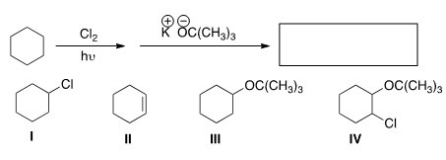
A) I
B) II
C) III
D) IV
Correct Answer

verified
Correct Answer
verified
Multiple Choice
Which of the labeled hydrogens is most easily abstracted in a free radical bromination reaction? 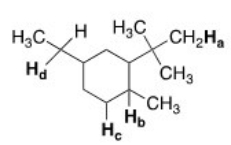
A) Ha
B) Hb
C) Hc
D) Hd
Correct Answer

verified
B
Correct Answer
verified
Multiple Choice
What is the product of the following reaction? 
A) I
B) II
C) III
D) IV
Correct Answer

verified
Correct Answer
verified
Multiple Choice
How many monochlorination products can be formed (constitutional isomers only) from the reaction of CH3CH2CH2CH2CH2CH3 with Cl2 and hn?
A) 3
B) 4
C) 5
D) 6
Correct Answer

verified
Correct Answer
verified
Multiple Choice
Rank the following radicals in order of increasing stability,putting the least stable first. 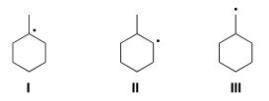
A) III< I < II
B) I < II < III
C) III < II < I
D) I < III < II
Correct Answer

verified
Correct Answer
verified
Multiple Choice
A possible reaction of ethane with chlorine is shown below. ![A possible reaction of ethane with chlorine is shown below. This reaction could conceivably occur by the following chain mechanisms [1],[2],and [3].The chain propagating step(s) is (are) ________. A) Only [1] and [2] B) Only [2] and [3] C) Only [1] and [3] D) Only [3]](https://d2lvgg3v3hfg70.cloudfront.net/TB7662/11eac43c_f7cc_d7dc_a9af_35bcc32c2ddf_TB7662_00.jpg) This reaction could conceivably occur by the following chain mechanisms [1],[2],and [3].The chain propagating step(s) is (are) ________.
This reaction could conceivably occur by the following chain mechanisms [1],[2],and [3].The chain propagating step(s) is (are) ________. ![A possible reaction of ethane with chlorine is shown below. This reaction could conceivably occur by the following chain mechanisms [1],[2],and [3].The chain propagating step(s) is (are) ________. A) Only [1] and [2] B) Only [2] and [3] C) Only [1] and [3] D) Only [3]](https://d2lvgg3v3hfg70.cloudfront.net/TB7662/11eac43c_f7cc_feed_a9af_07b5956a9ba5_TB7662_00.jpg)
A) Only [1] and [2]
B) Only [2] and [3]
C) Only [1] and [3]
D) Only [3]
Correct Answer

verified
Correct Answer
verified
Multiple Choice
How many monochlorination products,including stereoisomers,are formed from (S,S) -1,2-dimethylcyclopropane? 
A) 4
B) 3
C) 6
D) 5
Correct Answer

verified
Correct Answer
verified
Multiple Choice
Which steps are the rate-determining step in the mechanism of radical halogenation?
A) Initiation
B) Propagation
C) Termination
D) Initiation and propagation
Correct Answer

verified
B
Correct Answer
verified
Multiple Choice
Which of the following would be the fastest to form a radical? 
A) I
B) II
C) III
D) IV
Correct Answer

verified
Correct Answer
verified
Multiple Choice
Determine the monochlorination product(s) . 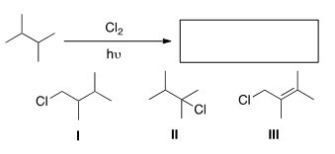
A) Only I
B) Only II
C) Only III
D) Only I and II
Correct Answer

verified
Correct Answer
verified
Multiple Choice
A possible reaction of ethane with chlorine is shown below. ![A possible reaction of ethane with chlorine is shown below. This reaction could conceivably occur by the following chain mechanisms [1],[2],and [3].Determine DH for step [2]. Bond dissociation energies (kcal/mol) : A) -5 kcal/mol B) +58 kcal/mol C) -28 kcal/mol D) None of the choices are correct.](https://d2lvgg3v3hfg70.cloudfront.net/TB7662/11eac43c_f7cd_4c11_a9af_331d5ca16c9c_TB7662_00.jpg) This reaction could conceivably occur by the following chain mechanisms [1],[2],and [3].Determine DH for step [2].
This reaction could conceivably occur by the following chain mechanisms [1],[2],and [3].Determine DH for step [2]. ![A possible reaction of ethane with chlorine is shown below. This reaction could conceivably occur by the following chain mechanisms [1],[2],and [3].Determine DH for step [2]. Bond dissociation energies (kcal/mol) : A) -5 kcal/mol B) +58 kcal/mol C) -28 kcal/mol D) None of the choices are correct.](https://d2lvgg3v3hfg70.cloudfront.net/TB7662/11eac43c_f7cd_7322_a9af_e19cad3a6d71_TB7662_00.jpg) Bond dissociation energies (kcal/mol) :
Bond dissociation energies (kcal/mol) : ![A possible reaction of ethane with chlorine is shown below. This reaction could conceivably occur by the following chain mechanisms [1],[2],and [3].Determine DH for step [2]. Bond dissociation energies (kcal/mol) : A) -5 kcal/mol B) +58 kcal/mol C) -28 kcal/mol D) None of the choices are correct.](https://d2lvgg3v3hfg70.cloudfront.net/TB7662/11eac43c_f7cd_7323_a9af_05f0337b043f_TB7662_00.jpg)
A) -5 kcal/mol
B) +58 kcal/mol
C) -28 kcal/mol
D) None of the choices are correct.
Correct Answer

verified
Correct Answer
verified
Multiple Choice
What is the product of the following reaction? 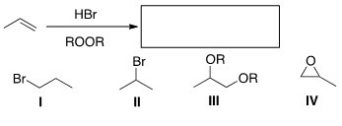
A) I
B) II
C) III
D) IV
Correct Answer

verified
Correct Answer
verified
Multiple Choice
Which of the following compounds contain tertiary (3°) radical carbons? 
A) Only I
B) Only II
C) Only III
D) Only II and IV
Correct Answer

verified
Correct Answer
verified
Multiple Choice
Which of the following compounds contain secondary (2°) radical carbons? 
A) Only I
B) Only II
C) Only III
D) Only II and IV
Correct Answer

verified
Correct Answer
verified
Multiple Choice
Which of the following compounds contain primary (1°) radical carbons? 
A) Only I
B) Only II
C) Only III
D) Only II and IV
Correct Answer

verified
Correct Answer
verified
Multiple Choice
Which of the following statements about radicals is true?
A) Cleavage of a stronger bond forms the more stable radical.
B) The stability of a radical increases as the number of alkyl groups bonded to the radical carbon decreases.
C) The higher the bond dissociation energy for a C-H bond,the more stable the resulting carbon radical.
D) Less stable radicals generally do not rearrange to more stable radicals.
Correct Answer

verified
Correct Answer
verified
Multiple Choice
Select the route that would most likely produce the desired results from the given starting material.  I.(1) H2SO4 and heat; (2) HBr II.(1) KOH in ethanol; (2) HBr
III) (1) H2SO4 and heat; (2) HBr + peroxides
IV) (1) potassium tert-butoxide in tert-butanol; (2) HBr + peroxides
I.(1) H2SO4 and heat; (2) HBr II.(1) KOH in ethanol; (2) HBr
III) (1) H2SO4 and heat; (2) HBr + peroxides
IV) (1) potassium tert-butoxide in tert-butanol; (2) HBr + peroxides
A) I
B) II
C) III
D) IV
Correct Answer

verified
D
Correct Answer
verified
Showing 1 - 20 of 51
Related Exams